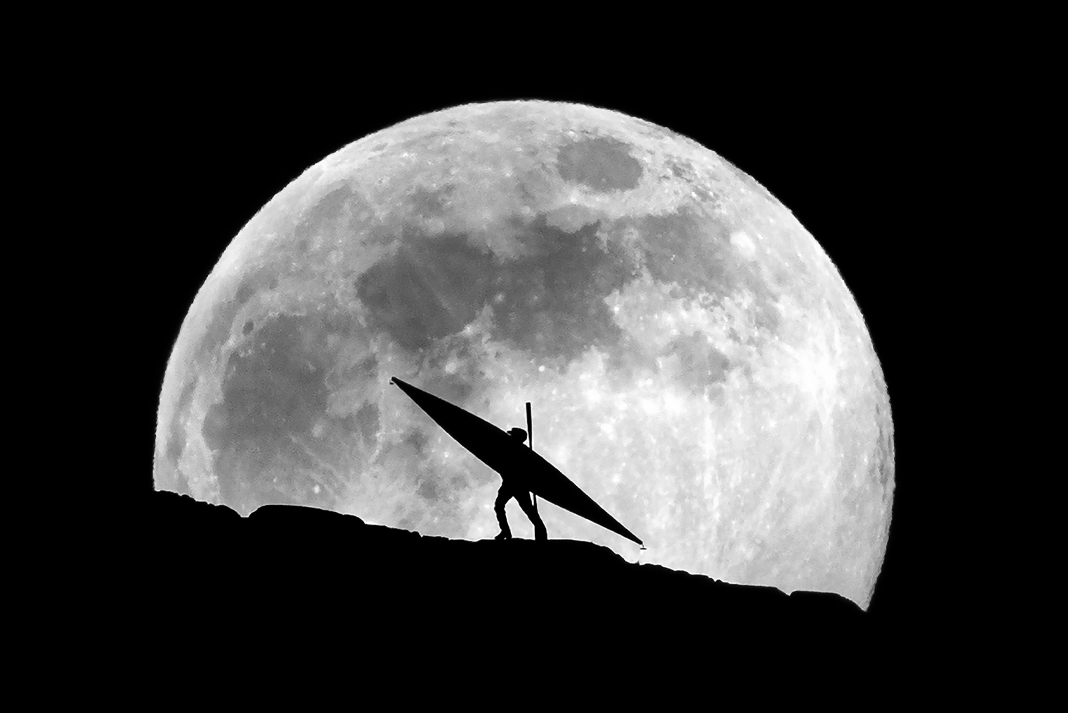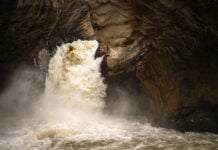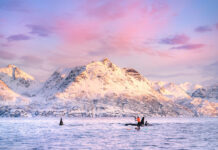I began my photography career in 2012 and four years later met James Manke, the kayaker in this photo. We’ve created some remarkable imagery together, although nothing quite compares to this unique moon shot.
Both of us come from a high-level sporting background. James is a member of the Hurricane Riders, a rough water sea kayaking collective. I won a gold medal for Canada at the 2008 Olympics in Beijing for rowing. A mutual passion for the water encouraged our friendship. He believed in the success of this seemingly crazy photo when I dreamt it up four years ago, inspired by similar lunar silhouettes from other sports.
While experimenting with lunar photography, photographer John Lehmann showed me The Photographers Ephemeris, an app that tracks the time and position of moon rise. Armed with this resource, 738-foot-tall Mount Douglas, just five minutes from my house in Victoria, British Columbia, seemed like a good location to make this silhouette photo come true. Once I was comfortable with how the moon interacted with the mountain, I asked James to help make the shot happen.
It took three years to come together because there are just 13 full moons in a year, so you have only 13 chances to try—a few more if you are willing to launch an attempt with an almost full moon. The date needed to work with my schedule, James’ schedule, and uncontrollable environmental factors, such as cloud cover. I practiced alone a few times, so when James brought his kayak, I was pretty sure we would get the photo.

This was our second try together. The conditions aligned on May 6, 2020. Moonrise over the ocean horizon was at 7:53 p.m. James got to the top of Mount Douglas 10 minutes early so he would have time to find a safe flat place to stand while it was still light. We used headsets connected to our phones to stay in constant contact and keep our hands free. The moon began to rise at 9 p.m., appearing to James’ right—exactly where I expected it to be.
As soon as the top half of the moon reached James in my viewfinder, I asked him to lift the kayak. I shot multiple frames as the moon rose. Even one foot left or right made a big difference when positioning James and the kayak in the center of the moon. James stood in a powerful stance to keep little details from getting lost. Aspects such as the placement of his arms and legs were important so every component stayed visible. To capture the thinner shape of the Greenland paddle, James held it at an angle to show off the intricate design.
It was only two minutes from the time the moon first touched James to the time it got too high. As quickly as the moment came, I witnessed the moon rise into the night sky like a child letting go of a balloon.
I had my camera set to manual with a shutter speed of 1/250, the ISO at 320 and aperture at f/10. I used a small aperture to ensure the moon and James would be sharp, and the lens was a 600mm f/4. I had the option to shoot wide open at f/4 and lower ISO, but I wanted to make sure the moon and the subject were both crisp. Using a monopod rather than a tripod allowed for a nimble and efficient setup that was easy to adjust in the dark.
The response to the photo has been astounding, especially from the kayaking community. Pictures like this usually have a mountain climber as their subject. This may have been the first time a kayaker has been photographed silhouetted in front of the moon.
Kevin Light is an Olympic gold medalist in Men’s Eight Rowing and a professional sports photographer.
This article was first published in Paddling Magazine Issue 62. Subscribe to Paddling Magazine’s print and digital editions here, or browse the archives here.
Supernatural delight, everybody was dancing in the moonlight. | Photo: Kevin Light








